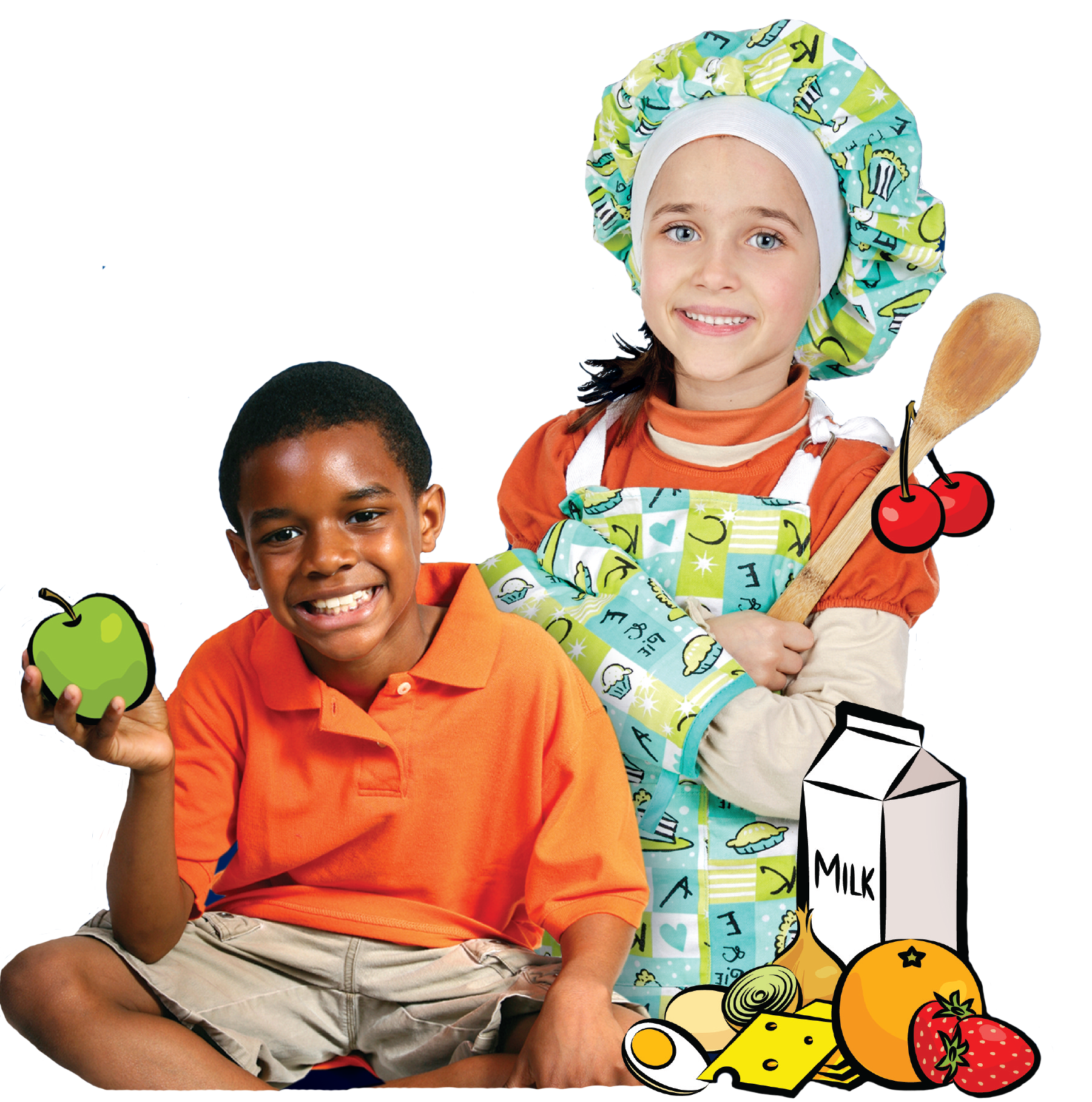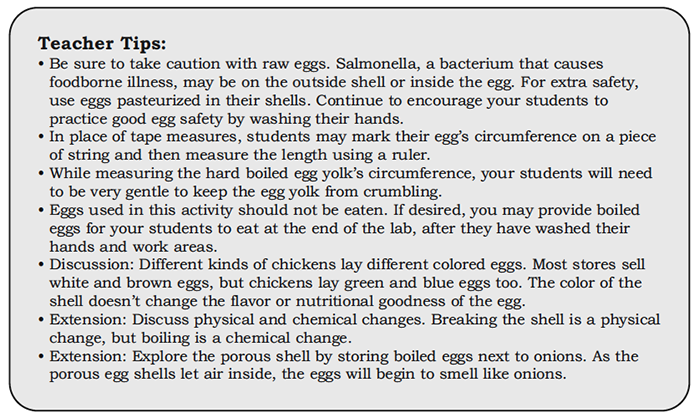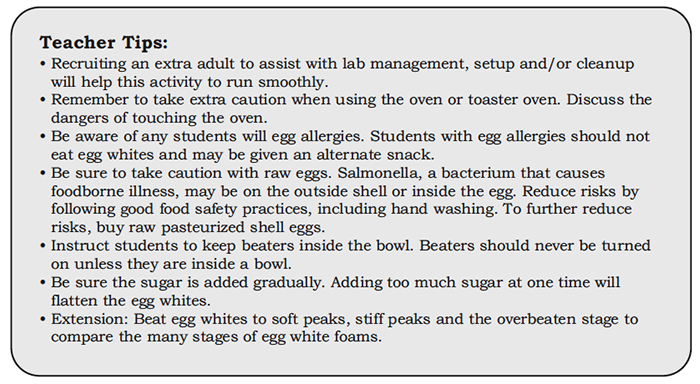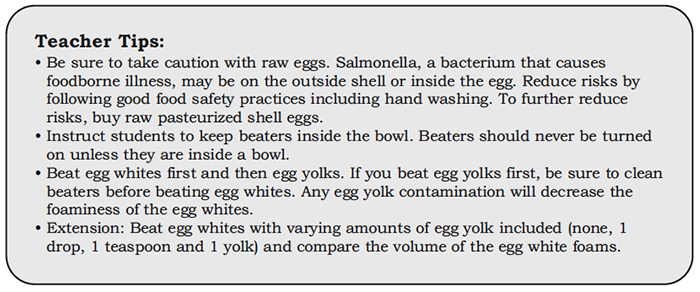Agricultural Literacy Curriculum Matrix
Lesson Plan
FoodMASTER: Eggs
Grade Level
Purpose
Students examine the process of egg production from the hen to our homes, explore the parts of an egg, perform measurements of circumference and height, compare raw egg whites to egg white foams, and prepare meringue cookies. Grades 3-5
Estimated Time
Materials Needed
Engage:
- 1 copy of Egg Interest Approach Pictionary Cards
Activity 1: Egg-ceptional Eggs
- For the teacher: 1 plate or bowl, 1 table knife, 1 paper towel, 1 egg, 1 hard boiled egg
- For each group: 3 plates or bowls, 2-4 hand lenses, colored pencils, 1-2 rulers, 1 food scale, 1-2 tape measures or five-inch strings, paper towels, 1 raw pasteurized shell egg, 1 hard boiled egg
- Student Handouts: Egg-ceptional Eggs and Scientific Inquiry: Egg Facts
- Teacher Answer Key
Activity 2: Fantastic Foams
- For the teacher: Toaster oven, 1-2 toaster oven cookie sheets, 1 egg separator, 1 mixing bowl, 1 table knife, 1 small bowl, 1 set measuring spoons, 1 set dry measuring cups, 1 hand mixer, oven mitts, hot pad holders, spatula, cooking spray, 3 eggs, 1/8 teaspoon cream of tartar, 1/2 teaspoon vanilla extract, 2/3 cup sugar, 1 tablespoon unsweetened cocoa powder, 1/3 cup semisweet chocolate chips
- For each student: 1 napkin
- Student Handouts: Fantastic Foams and Scientific Inquiry: Peaks, Peaks, Peaks
While You Wait Activity: Egg-citing Egg Foams
- For the teacher: 1 egg separator, 2 mixing bowls (small or medium), 1 table knife, 1-2 hand mixers, 1-2 liquid measuring cups, 2 eggs
Elaborate
Vocabulary
chalazae: the white strings on each side of the yolk that hold it in the center of the egg
membrane: a very thin skin or covering
porous: having tiny pores or holes
soft peaks: egg white foams that stand up at first and then fall over
stiff peaks: egg white foams that stand up with only the tips falling over
vitelline membrane: the skin around the yolk
Background Agricultural Connections
Introduction to FoodMASTER:
FoodMASTER (Food, Mathematics and Science Teaching Enhancement Resource) is a compilation of programs aimed at using food as a tool to teach mathematics and science. It is our theory that if food is used as a tool to teach mathematics and science, students will be better prepared to demonstrate and apply mathematic and scientific knowledge. Because students encounter food on a daily basis, they have preexisting contextual experiences preparing them for learning new and relevant mathematics and science material.
Food is conducive to hands-on and virtual, inquiry-based, active learning that uses multiple senses to engage students in the learning process. Utilizing food allows for an interdisciplinary approach to learning concepts and ideas in a variety of scientific subjects like general science, biology, chemistry, microbiology, nutrition, and health. Additionally, food labs are a dynamic way to teach mathematics concepts such as numbers and operations, algebra, geometry, measurement, and problem solving.
The knowledge and skill development that can be inspired by the FoodMASTER approach is limitless. Proper use of measurement tools, data collection and interpretation, application and generalization, classification and organization, graphing and comparative analysis, understanding chemical changes, observing functions of ingredients and controlling variables, pricing, critical thinking, self-directing learning, and team building are only a few of the potential knowledge and skill development areas for intermediate grade students experiencing FoodMASTER’s scientific inquiry labs.
Additional FoodMASTER Lessons
Additional FoodMASTER lessons can be found to cover health and nutrition topics such as:
- Food Safety
- Vegetables
- Fruits
- Milk and Cheese
- Meat, Poultry, and Fish
- Fats and Oils
- Grains
- Measurement
- Meal Management
Background for this Lesson:
Did you know a hen can lay 250 to 300 eggs a year? That’s a lot of eggs! In the United States, chicken eggs are the most popular, but you can eat duck eggs, goose eggs, ostrich eggs, and more. In this chapter, we will focus on chicken eggs.
Chicken eggs are an excellent source of protein, vitamins, and minerals. However, a microorganism called Salmonella can infect eggs and make you sick. Thoroughly cooking eggs makes them safe to eat because cooking kills Salmonella. To avoid foodborne illness, be sure everyone washes their hands after touching raw eggs and that no one eats raw eggs.
In this lesson, students will:
- list several parts of an egg and complete egg fact tables;
- make pictorial representations of the parts of an egg;
- practice measurement skills using appropriate units for weight, circumference, and height;
- make egg white foams and identify egg white soft peaks and stiff peaks;
- measure ingredients accurately and complete a Venn diagram comparing raw egg whites and egg foams; and
- make and test a prediction and measure time accurately.
Engage
- Play a game of Pictionary with your students to illustrate the steps of egg production from the farm to their home.
- Print one copy of the Egg Interest Approach Pictionary Cards and cut the six cards into separate pieces.
- Choose six students from your class and line them up at the board in chronological order from left to right.
- Give each student one card and instruct them to sketch their word until the class guesses it. Begin with student #1 and continue until all six students draw their word.
- After the class guesses each word, have the student read the additional facts on their card.
- When the game is complete, the Pictionary sketches will illustrate the path of egg production from the farm to our homes.
Explore and Explain
Activity 1: Egg-ceptional Eggs Scientific Inquiry: Egg Facts
- Read Egg-ceptional Eggs and complete the Doodle Bugs.
- Demonstrate how to crack a raw egg:
- Hold the egg over a plate.
- Gently tap the side of the egg shell with a table knife to crack the shell.
- Use both hands to gently pull the two sides of the shell apart.
- Pour the egg onto the plate.
- Discard the egg shell and wash your hands.
- Demonstrate how to peel the shell off a boiled egg:
- Use the dull end of your knife to tap the wider end of the egg shell.
- Make several small cracks in the egg shell.
- Use your fingers to peel the shell off the egg white (this can also be done under cool water).
- Place shell pieces on a paper towel and throw away.
- Instruct your students to read the Scientific Inquiry: Egg Facts directions, study the egg diagram, gather the supplies, and begin the activity. Remind the students to record their findings in the appropriate chart and to record units of measurement when appropriate.
- Review the use of measuring tapes and scales. The students will place a plate or bowl on the scale, zero the scale, and then add their egg, egg white, or egg yolk. Zeroing the scale makes the weight of the plate/bowl disappear.
- A teacher or other adult should break one raw egg for each group to study. Be sure to dispose of the egg when the group is finished with their observation.
- Review the parts of the egg and what the class learned about each part.

Activity 2: Fantastic Foams Scientific Inquiry: Peaks, Peaks, Peaks
- Read Fantastic Foams and complete the Doodle Bugs.
- Follow Scientific Inquiry: Peaks, Peaks, Peaks directions to make meringue cookies.
- Demonstrate how to separate egg whites from yolks:
- Place the egg separator over the mixing bowl. (A helper may hold the egg separator.)
- Gently tap the side of the egg shell with a knife to crack the shell.
- Use both hands to gently pull the two sides of the shell apart.
- Pour the egg into the egg separator. The egg white will fall into the bowl and the yolk will stay in the egg separator and be discarded.
- Allow your students to take turns beating the egg whites, adding ingredients, and dropping teaspoonfuls of meringue onto cookie sheets.
- While beating the egg whites, ask your students to make observations about visible changes (size, color, state of matter). Be sure to point out soft and stiff peaks.
- Instruct the students to complete the Venn diagram.
- While the cookies are baking, complete While You Wait: Egg-citing Egg Foams.
- When the cookies are done, an adult should use oven mitts to remove the cookie sheets from the oven. Place the cookie sheets on the hot pad holders.
- Let the cookies cool. Remove the cookies from the tray with a spatula and place on napkins.
- Serve one cookie to each student. Have the students answer the Tasting Time questions.

While You Wait: Egg-citing Egg Foams
- Instruct your students to make a prediction before you begin beating the egg whites and yolks.
- Allow the students to assist with beating the egg whites and yolks and measuring the volume of the foams.
- Instruct the students to record times and volumes on their workbook pages.
- Discuss the differences between the egg foams. Remind students that egg whites are mainly protein and yolks contain both protein and fat. The protein makes the egg foams strong. Whereas, fat prevents foaming.

Elaborate
-
Farmers Market Tour: Arrange a tour of your community's farmers market in the fall or spring to observe the variety of food items farmers have produced. Assign students to talk with the farmers to learn more about what they do. If a real tour is not possible, have students do a virtual tour online or invite local farmers to talk about their role and the work they do in your community.
-
Visit the Interactive Map Project website and view the map representing Egg Production in the United States. Identify the state that produces the most eggs, then find where your state ranks for egg production.
-
Egg Spectrum: Complete the math enrichment activity. Students will compare various colors of egg shells, identify egg nutrients, and perform calculations using eggs.
Evaluate
After conducting these activities, review and summarize the following key concepts:
- The eggs we eat are typically produced by chickens on farms.
- It's important to thoroughly cook eggs to decrease the chance of becoming sick from a foodborne illness.
- Eggs are a good source of protein.
Acknowledgements
- Created by: FoodMASTER (Food, Math, and Science Teaching Enhancement Resource)
- Sponsored by: SEPA (Science Education Partnership Award)
- Partnered with: Ohio University and East Carolina University
- Graphics provided by FoodMASTER
Recommended Companion Resources
- Chicks & Chickens
- Eat Happy Project Video Series
- Eggs 101: An Egg's Journey from the Farm to Our Tables
- Eggs in Schools
- Food Group Puzzle
- Hatching Classroom Projects
- Hatching Science: 21 Days of Discovery Video
- Inside An Egg
- Look Inside Food
- One Egg
- The Science of Cooking
- Virtual Chicken
- Virtual Egg Farm Field Trips
Author
Organization
| We welcome your feedback! If you have a question about this lesson or would like to report a broken link, please send us an email at matrixelearning@gmail.com. If you have used this lesson and are willing to share your experience, we will provide you with a coupon code for 10% off your next purchase at AgClassroomStore. |
